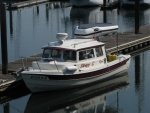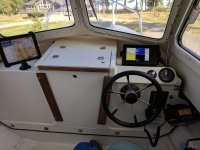Finally got around to updating the electronics in my 16. The Lowrance chartplotter/sounder worked OK, but with no permanent VHF installed I took the opportunity to go modern with all the AIS/DSC/NMEA 2000 goodies.
Made for a very nifty setup. Lots of great function, reasonably priced and it fits the 16 Angler like a glove.
Components:
- Garmin echoMAP Chartplotter/Sonar 74sv w/Traditional, ClearVü and SideVü transponder
- Lowrance Link-8 VHF (NMEA 2000, AIS/DSC)
- Morad VHF-156HD antenna
- Various NMEA 2000 cables/connectors
All told, I was into this about $1500.
Plenty of this has been discussed at length here before, but I'll go over the major parts from start to finish.
First up - remove all the old junk. And of course...fix the holes in the transom that were simply "screwed and glued." Fortunately, a very minor overdrilling of the existing screw holes showed nothing but dry balsa - so some thickened epoxy filled those right up.
For the new transducer, I went with the Starboard mounting block setup. Not wanting to risk getting it in the wrong place, nor knowing what else might be added to it down the road - I went larger than was probably necessary.
1" Starboard would have been nice, but all I had was 1/2" - so I doubled up a couple pieces. I wanted the block as far down as possible to give maximum adjustability of the transducer, but I didn't want the outside edge of the block to extend below the hull given that the transom is angled slightly back. My primary concern being that might introduce turbulence that might impact transducer function - so a slight bevel on the table saw took care of that.
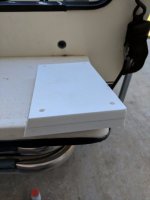
The Starboard block was to be mechanically affixed with four 1/4" stainless machine screws. So, four new 1/2" holes were drilled out all the way to the rear fiberglass skin. Dremel with small drum sander hogged out more balsa inside the holes.
Filling holes in a vertical surface has been discussed here before, so I stole the nifty idea of drilling small, angled weep holes from the top down into the main hole cavity. A small piece of Starboard scrap got the angles just right and served as a jig.
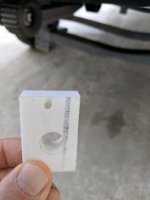
Using a 1/2" drill bit to hold the jig in place, the weep holes were carefully drilled.
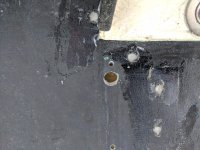
A batch of epoxy was mixed up, then all exposed balsa inside the holes was first hit with unthickened epoxy using a Q-tip. This step stolen from Sunbeam - made sense to me, as unthickened epoxy would more easily get sucked into the grain of dry balsa.
I then thickened the batch, just to the point I thought it would still flow out the weep holes - then filled each hole from the bottom with a plastic turkey injecting syringe with the tip cut off to 1/8" or so. Once air bubbles ceased and nothing but epoxy flowed out the top holes, blue painters tape quickly covered the 1/2" holes.
I then waited several hours until the epoxy went into that green, easily cut stage - and removed the tape. Just to get things perfect as I could, I then mixed up another very small batch of epoxy - this time, thickened to peanut butter consistency so it wouldn't flow. This final coat filled the small voids in the 1/2" and small weep holes, which I left a tad proud of the surface. Again, wait until green stage - then slice it with a sharp chisel for a perfectly flush finish to the edge of the hull.
After letting it cure for 24 hours, the epoxy plugs were drilled and tapped for 1/4" machine screws. Block was attached, with screws coated in unthickened epoxy.
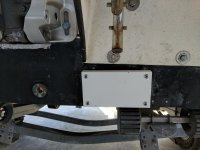
From here, a large framing square was used to line up the transducer and bracket just right. I started with the common suggestion of 1/4" below the bottom of the hull, mounting the adjustable bracket in the middle of its range. Spoiler: Turned about to be perfect, described below.
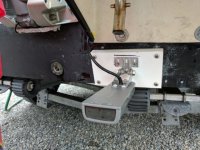
From the side:
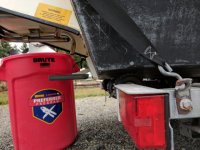
The interior install was by comparison, pretty dang basic. Plug everything in and screw it all down. NMEA 2000 makes the networking/integration super simple - plug the Garmin and Link-8 into the bus (along with power), terminate the ends, turn everything on. The only minor exception being, the Link-8 wants to fetch GPS location via NMEA 0183 by default - you have to dig into the radio settings to tell it to fetch via NMEA 2000.
There's not much room at the 16 Angler helm, but I found the location shown below satisfactory for the VHF. Just barely fits...without being a knee banger, or getting in the way of the throttle.
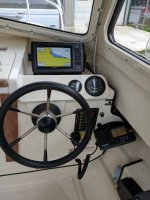
Lastly, the Morad antenna everyone says is the best. I hate unnecessary holes in a boat, but was initially resigned to drilling on at the front of the cabin and attaching the antenna to a rail mount. However, after staring and playing around with things for a while - I ended up with it attached to the hand rail as shown. Hand rail use is barely impacted, and a simple tuck of the cable brings it into the cabin.
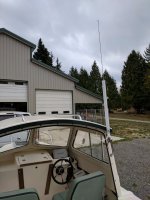
So...how does it all work? Incredibly well. The Garmin - at least for me - is truly a "no manual needed" piece of equipment. Everything is logical, easily found and adjusted, and just flat out works. And, you couldn't find a display that first the 16 Angler console better. The more expensive Garmin 742xs was suggested to me, and if you think you must have touch screen capability - perhaps that's better for you. Me - I hate touch screens on a boat. Especially something like the 16, with its significant bobbing...gimme buttons any day, and I'll gladly pocket the savings as an added benefit.
Back to the sounder performance, as referenced above - it's pretty amazing. As mentioned routinely here, the best most folks get is holding bottom at medium speeds, when the depth isn't extreme. On my test run out of Port Angeles - I was into 300+ feet of water, and holding bottom perfectly - at 20+ knots. Never once lost bottom, at any speed or depth. Far and away the best performance of any sounder I've used, although my experience is limited compared to many.
The VHF - I'm sure many good options exist other than the Lowrance Link-8, but I picked it up for several reasons. It's cheap, it's NMEA 2000, it works well, and perhaps most importantly for me - it's the same unit I have on my Nordic, so I'm familiar with it. Combined with the Morad 156HD antenna, reception was pretty decent...I was picking up AIS targets from about miles away out on the Strait. From my house - without a clear line of sight - I'm picking up AIS targets at the Port Angeles marina from almost 15 miles away.
Made for a very nifty setup. Lots of great function, reasonably priced and it fits the 16 Angler like a glove.
Components:
- Garmin echoMAP Chartplotter/Sonar 74sv w/Traditional, ClearVü and SideVü transponder
- Lowrance Link-8 VHF (NMEA 2000, AIS/DSC)
- Morad VHF-156HD antenna
- Various NMEA 2000 cables/connectors
All told, I was into this about $1500.
Plenty of this has been discussed at length here before, but I'll go over the major parts from start to finish.
First up - remove all the old junk. And of course...fix the holes in the transom that were simply "screwed and glued." Fortunately, a very minor overdrilling of the existing screw holes showed nothing but dry balsa - so some thickened epoxy filled those right up.
For the new transducer, I went with the Starboard mounting block setup. Not wanting to risk getting it in the wrong place, nor knowing what else might be added to it down the road - I went larger than was probably necessary.
1" Starboard would have been nice, but all I had was 1/2" - so I doubled up a couple pieces. I wanted the block as far down as possible to give maximum adjustability of the transducer, but I didn't want the outside edge of the block to extend below the hull given that the transom is angled slightly back. My primary concern being that might introduce turbulence that might impact transducer function - so a slight bevel on the table saw took care of that.

The Starboard block was to be mechanically affixed with four 1/4" stainless machine screws. So, four new 1/2" holes were drilled out all the way to the rear fiberglass skin. Dremel with small drum sander hogged out more balsa inside the holes.
Filling holes in a vertical surface has been discussed here before, so I stole the nifty idea of drilling small, angled weep holes from the top down into the main hole cavity. A small piece of Starboard scrap got the angles just right and served as a jig.

Using a 1/2" drill bit to hold the jig in place, the weep holes were carefully drilled.

A batch of epoxy was mixed up, then all exposed balsa inside the holes was first hit with unthickened epoxy using a Q-tip. This step stolen from Sunbeam - made sense to me, as unthickened epoxy would more easily get sucked into the grain of dry balsa.
I then thickened the batch, just to the point I thought it would still flow out the weep holes - then filled each hole from the bottom with a plastic turkey injecting syringe with the tip cut off to 1/8" or so. Once air bubbles ceased and nothing but epoxy flowed out the top holes, blue painters tape quickly covered the 1/2" holes.
I then waited several hours until the epoxy went into that green, easily cut stage - and removed the tape. Just to get things perfect as I could, I then mixed up another very small batch of epoxy - this time, thickened to peanut butter consistency so it wouldn't flow. This final coat filled the small voids in the 1/2" and small weep holes, which I left a tad proud of the surface. Again, wait until green stage - then slice it with a sharp chisel for a perfectly flush finish to the edge of the hull.
After letting it cure for 24 hours, the epoxy plugs were drilled and tapped for 1/4" machine screws. Block was attached, with screws coated in unthickened epoxy.

From here, a large framing square was used to line up the transducer and bracket just right. I started with the common suggestion of 1/4" below the bottom of the hull, mounting the adjustable bracket in the middle of its range. Spoiler: Turned about to be perfect, described below.

From the side:

The interior install was by comparison, pretty dang basic. Plug everything in and screw it all down. NMEA 2000 makes the networking/integration super simple - plug the Garmin and Link-8 into the bus (along with power), terminate the ends, turn everything on. The only minor exception being, the Link-8 wants to fetch GPS location via NMEA 0183 by default - you have to dig into the radio settings to tell it to fetch via NMEA 2000.
There's not much room at the 16 Angler helm, but I found the location shown below satisfactory for the VHF. Just barely fits...without being a knee banger, or getting in the way of the throttle.

Lastly, the Morad antenna everyone says is the best. I hate unnecessary holes in a boat, but was initially resigned to drilling on at the front of the cabin and attaching the antenna to a rail mount. However, after staring and playing around with things for a while - I ended up with it attached to the hand rail as shown. Hand rail use is barely impacted, and a simple tuck of the cable brings it into the cabin.

So...how does it all work? Incredibly well. The Garmin - at least for me - is truly a "no manual needed" piece of equipment. Everything is logical, easily found and adjusted, and just flat out works. And, you couldn't find a display that first the 16 Angler console better. The more expensive Garmin 742xs was suggested to me, and if you think you must have touch screen capability - perhaps that's better for you. Me - I hate touch screens on a boat. Especially something like the 16, with its significant bobbing...gimme buttons any day, and I'll gladly pocket the savings as an added benefit.
Back to the sounder performance, as referenced above - it's pretty amazing. As mentioned routinely here, the best most folks get is holding bottom at medium speeds, when the depth isn't extreme. On my test run out of Port Angeles - I was into 300+ feet of water, and holding bottom perfectly - at 20+ knots. Never once lost bottom, at any speed or depth. Far and away the best performance of any sounder I've used, although my experience is limited compared to many.
The VHF - I'm sure many good options exist other than the Lowrance Link-8, but I picked it up for several reasons. It's cheap, it's NMEA 2000, it works well, and perhaps most importantly for me - it's the same unit I have on my Nordic, so I'm familiar with it. Combined with the Morad 156HD antenna, reception was pretty decent...I was picking up AIS targets from about miles away out on the Strait. From my house - without a clear line of sight - I'm picking up AIS targets at the Port Angeles marina from almost 15 miles away.

